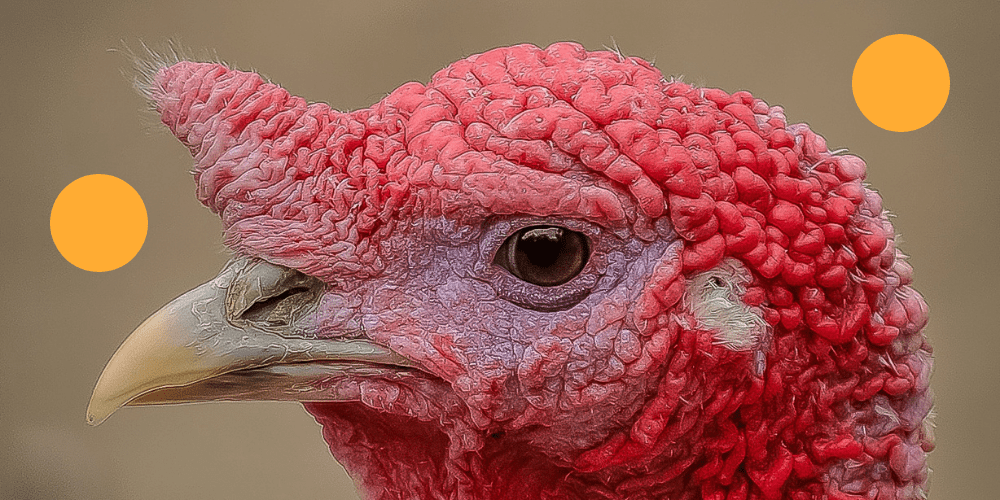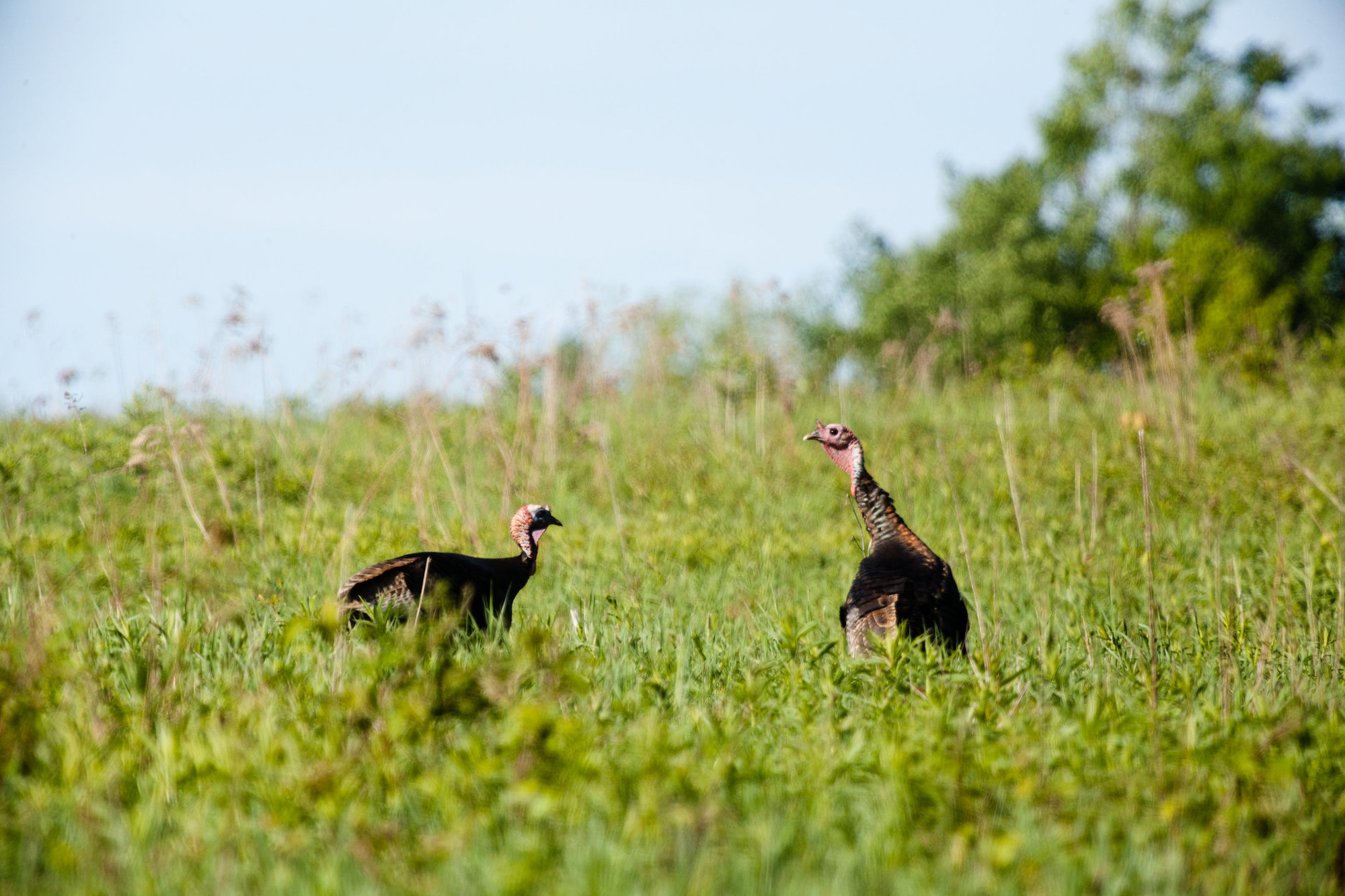Wild turkeys have incredible eyesight. Their ability to sense a predator, like a hunter leaning back against a tree, is uncanny. Turkey vision can seem even supernatural at times. But really, it’s just a combination of evolution and physiology. There’s still plenty we don’t know about how turkeys see, but researchers have uncovered plenty of interesting facts, many of which can be useful to hunters.
We know that a turkey’s vision is three times sharper than our own. They can also see nearly eight times farther than we can, and their color vision is far more enhanced than ours. Turkey vision has evolved over the course of millions of years to help them spot predators, locate mates, and identify challengers. Understanding how turkeys see and perceive danger just might help improve your hunting setups this spring.
As spring turkey season approaches, many hunters have a burning question – can turkeys see blaze orange? The answer has important implications for hunter safety and success.
After analyzing the latest research and experiences from the field, it seems turkeys can see orange to some degree, but it may not spook them as much as you’d think. Here’s a comprehensive look at what science and hunters show about turkeys and their ability to see blaze orange.
Turkeys Have Excellent Color Vision
There’s no doubt about it – turkeys have amazing color vision compared to humans. Their eyes have four types of color cones, allowing them to see more hues than we can perceive.
This extra color perception evolved to help turkeys find food, choose mates, and spot predators. If something looks unnatural in their environment, like a block of fluorescent orange, they’ll likely notice it
So yes, turkeys can physically see blaze orange. But that doesn’t automatically mean it will send them running.
Motion Matters More Than Color
Turkeys rely heavily on their sharp vision to detect danger. But several scientific studies show they are far more sensitive to movement and shapes than specific color tones.
In one experiment hunters wore full blaze orange with a camo face net and sat completely still in the woods. Turkeys walked within mere feet of them seemingly unbothered by the orange jackets.
Why? The turkeys focused on the lack of movement, not the strange color. With no motion, they didn’t perceive a threat.
This suggests blaze orange alone is unlikely to spook turkeys if you remain perfectly still. Quick motions will flush them no matter what color you’re wearing.
Consider A Turkey’s Behavior
Mature gobblers are extremely wary, while jakes and hens may be more tolerant of odd sights. Still, even dominant toms seem to ignore still blaze orange.
Turkeys also see bright orange oak leaves in the fall. So while orange clothing looks unnatural to our eyes, it doesn’t immediately signal danger to them.
Additionally, turkeys have relatively poor depth perception due to their wide field of vision. Blaze orange may register only as a distant, meaningless blob if you sit motionless.
Use Blaze Orange Strategically
Given a turkey’s focus on movement over color, blaze orange can be an effective safety strategy if used correctly. Here are some tips:
-
Wear an orange hat or vest when walking to your spot in low light. Take it off once settled.
-
Tie an orange bandana high in your tree stand to be seen from a distance. Keep your body concealed below.
-
Carry an orange vest to wave only if needing to alert another hunter. Don’t wave randomly.
-
Place an orange hat or flag behind your setup so others see you, but not the turkeys.
Blaze orange is crucial in fall with more hunters around. With smart strategies, you can safely use it in spring too.
The Bottom Line
Science shows turkeys notice orange but don’t inherently fear it. A blaze orange system plus total motion discipline is your best approach for an effective hunt.
Turkeys can see color, but motion and sound will bust you faster. With a detailed understanding of their vision, you can use blaze orange safely during turkey season.
So can turkeys see orange? Yes, but not in the same way we do. Use this knowledge to improve your concealment and safety this spring.

Turkeys Can See in All Directions at Once
When it comes to keeping an eye out for predators, a wild turkey’s greatest asset is its ability to see in all directions at once. Turkeys have monocular vision, which means their eyeballs function independently of one another. (As opposed to our own binocular vision that uses both eyes in concert.) This gives the birds a 270-degree field of vision when their heads are perfectly still. But as most turkey hunters know, this is rarely the case.
“If you pay attention, [turkeys] turn their heads constantly. And because their eyes are working independently, that offers them a 360-degree field of view,” says Dr. Mike Chamberlain, a Distinguished Professor at the University of Georgia who’s been researching wild turkeys for the past 30 years. “Whereas you and I have peripheral vision, but we can’t see above or behind us, turkeys can. By changing their head posture constantly, it allows their eyes to pick up movement as two independent periscopes.”

Chamberlain says turkeys also rely on their keen sense of hearing to augment their vision. Working in combination, these two senses allow them to quickly and accurately pinpoint potential predators and other turkeys.
“Their hearing is the same in the sense that each ear registers the sound independently and transmits it to their brain. Coupled with their vision, they can hear something, look in that direction, and they can pinpoint exactly where that sound is coming from,” he explains. “That’s why they have that uncanny ability [to locate other birds]. You call at them from the tree, and ten minutes later they’re standing right there at the tree.”
The biggest trade-off for being able to see in all directions at once is that turkeys don’t have clear depth perception. The classic turkey head bob helps with this shortcoming, according to The Wild Turkey: Biology and Management, a book that was published in 1992 by the National Wild Turkey Federation and edited by Dr. James G. Dickson.
“Though the three dimensions of space cannot be clearly perceived,” Dickson writes, “the turkey can determine relative distances by a slight turning of its head and viewing an object at different angles.”
Turkeys Can See Color–Better Than Us
Of all the vertebrate species on the planet today, birds have the most complex retinas. Accordingly, they perceive a larger and richer spectrum of colors than humans and other mammals do.
Without getting too deep into eyeball science, the human retina has four types of photoreceptors, consisting of one rod and three single cones. Rods help us see in low light, while cones help convert light into color signals, allowing us to see short, moderate, and long wavelengths of blue, green, and red.
A turkey’s retina, on the other hand, has seven different types of photoreceptors: one rod, four single cones, and two double cones. This allows turkeys (and other birds) to see a spectrum of colors that are imperceptible to the naked human eye.
Dr. Chamberlain tells Outdoor Life that there’s some debate among the scientific community about whether or not turkeys can see in the UV spectrum. Regardless, he says, their color vision is “extremely acute.” This gives the birds another advantage when scanning their surroundings for predators.
“They can just pinpoint colors so well,” Chamberlain says. “Blues, blacks, and other things in their environment that may not look natural, they can pick these out immediately.”
The importance of color goes beyond predator detection, however. Hen turkeys use their enhanced color vision to seek out mates, as the fitter, more dominant toms are always more colorful than the others.
A strutting tom makes his presence known. Adobe stock
“If you’re a dominant male, you’re going to breed more than a subordinate tom,” Chamberlain explains. “They’re more fit and more aggressive. They have longer snoods, more colorful heads, and more iridescence [in their feathers].”
Turkeys also have the amazing ability to change their head color to communicate and express emotions, like when a strutting gobbler’s head transitions from bluish-white to a bright reddish color.
YOU’RE AIMING WRONG! Turkey Shot Placement | Shotgun Turkey Hunting
FAQ
Can turkeys see the color orange?
Yes, Turkeys See Blaze Orange – Pull the vest as high into the tree above your blind as possible, hopefully raising it above a turkey’s common line of sight.
Should you wear orange when turkey hunting?
If you are hunting turkey, don’t wear blaze orange. Turkeys will see you a mile away and you more than likely won’t even have a shot at one if you wear orange. Bowhunters don’t need to wear it and to be honest, the blaze isn’t what is going to spook deer, it’s your smell and noise you are making.
Do turkeys see in 2D or 3D?
They have excellent visual acuity during daylight hours. They lack 3D vision, but compensate by bobbing their heads up and down to gather information about their surroundings. They have excellent peripheral vision to alert them of nearby predators.
What colors not to wear while turkey hunting?
Never wear bright colors, especially not red, white, blue or black because these are the colors of a wild turkey gobbler. Watch out for red, white or blue on your socks, t-shirts, hooded sweatshirts, hats, bandannas, etc. Wear dark undershirts and socks, and pants long enough to be tucked into boots.
Do turkeys have binocular vision?
Turkeys have monocular vision, which means their eyeballs function independently of one another. (As opposed to our own binocular vision that uses both eyes in concert.) This gives the birds a 270-degree field of vision when their heads are perfectly still. But as most turkey hunters know, this is rarely the case.
Can a wild turkey see in all directions?
When it comes to keeping an eye out for predators, a wild turkey’s greatest asset is its ability to see in all directions at once. Turkeys have monocular vision, which means their eyeballs function independently of one another. (As opposed to our own binocular vision that uses both eyes in concert.)
Why do turkeys change their head color?
Turkeys also have the amazing ability to change their head color to communicate and express emotions, like when a strutting gobbler’s head transitions from bluish-white to a bright reddish color. In the 1992 book, Dr. Dickson points out that in addition to their regular outer eyelids, wild turkeys have translucent inner eyelids.
How often do turkeys close their eyes?
“Close observation of 8 imprinted adult [turkeys] of both sexes by the first author showed a frequency of 78 to 92 closings per minute of this third eyelid,” Dickson wrote, referring to a study conducted in 1967. In this sense, a turkey’s eyeballs are like a pair of self-cleaning optics.
Do turkeys have a good sense of hearing?
Chamberlain says turkeys also rely on their keen sense of hearing to augment their vision. Working in combination, these two senses allow them to quickly and accurately pinpoint potential predators and other turkeys. “Their hearing is the same in the sense that each ear registers the sound independently and transmits it to their brain.
Do turkeys turn their heads constantly?
But as most turkey hunters know, this is rarely the case. “If you pay attention, [turkeys] turn their heads constantly.
